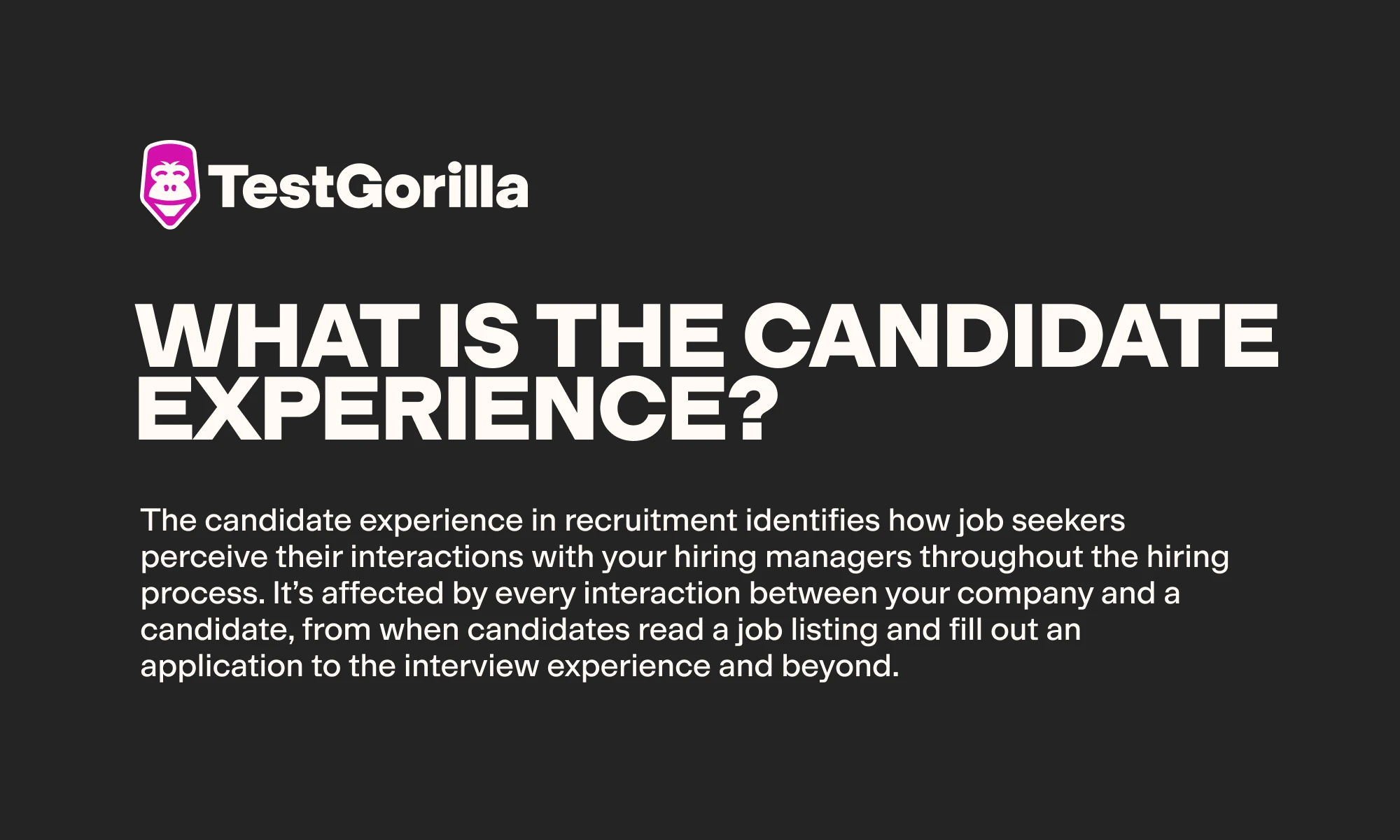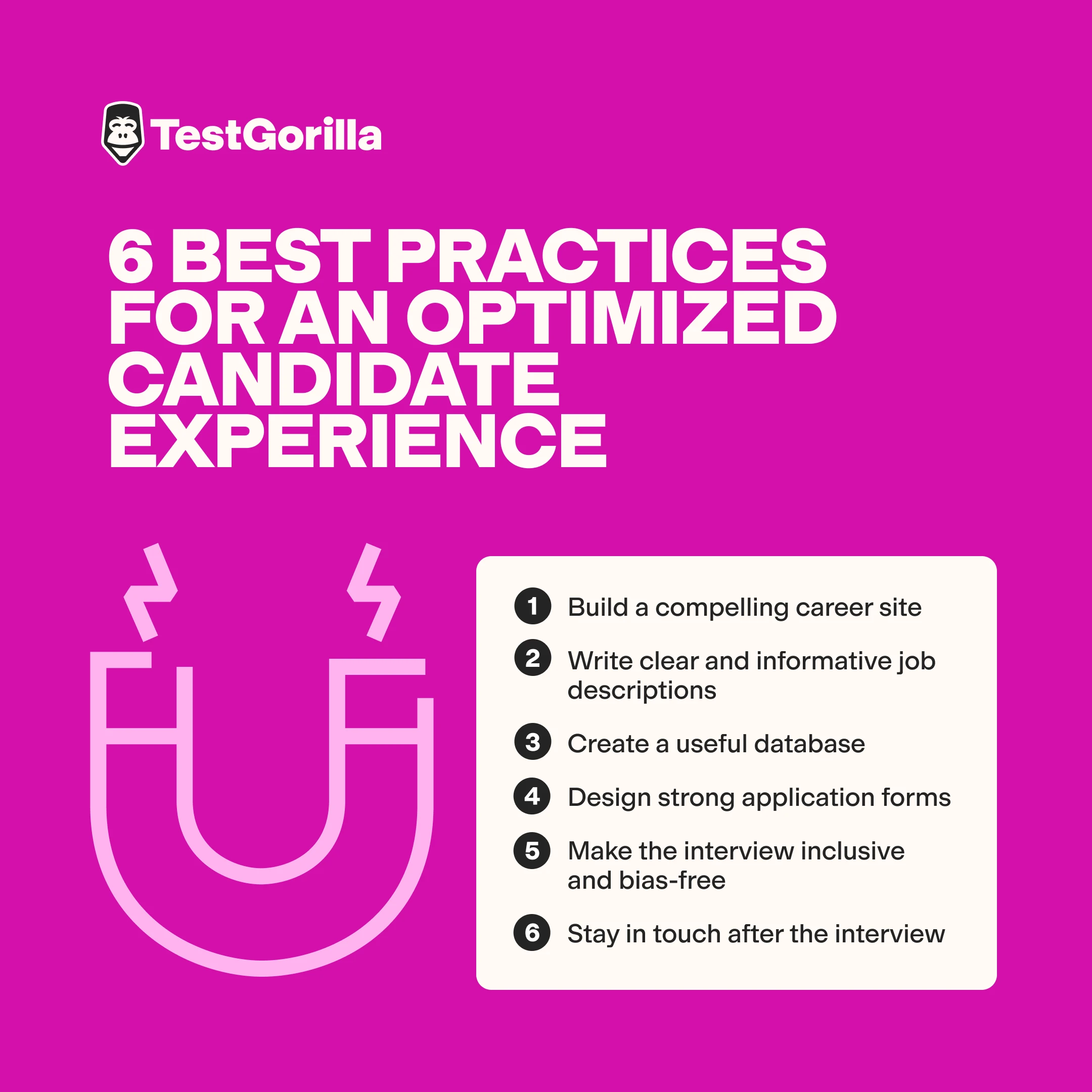Optimize the candidate experience with skills-based hiring
Hiring and retaining top talent isn’t easy. Candidates are looking for more than just outstanding salaries and benefits packages. They want to see evidence that your company puts their needs first in the form of an impressive candidate experience.
A holistic approach to improving candidate experiences, focused on simplifying the application process, using skill assessments to make objective hiring decisions, and communicating consistently, helps you attract and retain amazing staff.
In this article, we discuss the candidate experience, why it’s crucial, and the techniques that transform your recruitment strategy to attract quality candidates.
What is the candidate experience?
The candidate experience in recruitment identifies how job seekers perceive their interactions with your hiring managers throughout the hiring process. It’s affected by every interaction between your company and a candidate, from when candidates read a job listing and fill out an application to the interview experience and beyond.
The impact of candidate experience doesn’t end with a job offer or rejection.
For successful candidates, the candidate experience continues into the pre-boarding and onboarding process once you hire them.
For rejected candidates, it concludes with rejection communications and the feedback you offer after an interview.
Positive candidate experiences give candidates an optimistic feel about your organization and recruitment strategy.
What a great candidate experience looks like
A great candidate experience contains a series of interactions that leave applicants feeling valued, respected, and enthusiastic about the organization, regardless of the outcome of their application.
Here’s a step-by-step snapshot of an incredible candidate journey:
Job search: A positive candidate experience starts with a simple job-seeking process. Make your career page easy to find, write clear and detailed job descriptions, and design a mobile-friendly website.
Application: A complex application process discourages candidates from working with your company. Ask only for essential information, and ensure candidates can complete forms on any device.
Interviews: As the first face-to-face contact with an applicant, interviews provide an opportunity to strengthen human relationships with candidates. Focus on delivering a fair, professional, and standardized interview process. Follow up with timely interview feedback for every candidate.
Offers, onboarding, and beyond: After selecting the most suitable candidate, send them an offer and share the next steps. Incorporate onboarding best practices to make them feel welcome and ready to hit the ground running.
Want to dive deeper into employee onboarding?
Read our complete guide. It’s packed with tips, step-by-step strategies, and industry insights —to build a seamless employee onboarding plan.
Why candidate experience is important
The prevailing skills shortage, talent wars, and an employee’s job market have brought candidate relationship management to the forefront of HR recruiting team efforts.
How you make a candidate feel matters. If your candidate's experience is poor, it may lead to strong applicants abandoning the job application process. Candidates may withdraw due to unfair demands, such as the request to complete an unpaid trial or a lack of communication after the interview.
Since many candidates share a bad experience online or with a friend, the ripple effect of a bad candidate experience makes talent acquisition much harder. It could deter future candidates from applying for roles.
When you invest in ways to improve candidate experience, you benefit from:
Benefit | Outcome |
Enhanced employer branding | Employer branding influences how job seekers perceive a business. Candidates who share positive reviews about their experience with your company help attract talent to your business. |
Access to more applicants | Following candidate experience best practices encourages unsuccessful applicants to reapply for future roles and inspires new hires to advocate for your brand and engage in employee referral programs. |
Improved acceptance rate | Candidates are more likely to accept a job offer from a company that prioritizes candidate experience best practices, such as committing to regular communication. An increased offer acceptance rate reduces the time and money you spend on recruitment. |
If these benefits sound too good to be true, don’t just take our word for it. Real companies like DS Worx increased application completion rates, reduced hiring time, and boosted hiring efficiency with TestGorilla’s skill assessments.
The best insights on HR and recruitment, delivered to your inbox.
Biweekly updates. No spam. Unsubscribe any time.
6 best practices for an optimized candidate experience
According to research by the Talent Board, companies with great candidate experience have four key things in common:
They communicate with the candidate consistently
They set clear expectations for all stages of the hiring process
They have a fair hiring process
They track candidate experience metrics regularly
You can achieve these standards by implementing the following six candidate experience best practices:
1. Build a compelling career site
A good careers page establishes your broad benchmarks for performance and what your employees get for meeting these, such as:
Financial compensation: A clear, fair salary range for each role. You may also discuss bonus schemes, benefits, and how you approach salary negotiations.
Professional development opportunities: Mentoring opportunities, coaching, training strategies, and development courses.
A great work-life balance: How you support work-life balance with flexible scheduling, hybrid work strategies, and regular breaks.
A sense of purpose in their work: Insights into how you deliver feedback and how each employee’s work impacts your business.
Airbnb is a good example. Its careers page clearly articulates its workplace philosophy, which ties in closely with its central ethos as a business: global flexibility.
Airbnb makes a great first impression, telling candidates its most important selling point: an exceptional employee experience, living and working from anywhere.
2. Write clear and informative job descriptions
A clear and informative job description is crucial for providing candidates with the information they need to determine whether your role suits them and is a necessary step for a good candidate experience.
Your job postings should be simple (free from lengthy explanations and jargon) but informative enough to answer candidates' questions about the role and the company. Include the following information:
Job title and purpose: Use a clear, descriptive job title, and explain why the role exists in your company.
Necessary skills: Which skills must candidates have based on the role's responsibilities? How can you validate those skills? For instance, if you’re hiring a programmer, you might use a JavaScript test.
Responsibilities: Outline the role's duties, including candidates' supervisory responsibilities and who they report to.
Benefits and salary ranges: Don’t just tell candidates you’re offering a “competitive salary.” Share a precise salary range. Mention any additional benefits you can offer, such as funding for training or flexible work options.
Your job descriptions may include additional details, such as tips on preparing for the application process, insights into the skill tests you plan to conduct, and a basic timeline for when to expect feedback that keeps the candidate’s time at the fore.
3. Create a useful database
Use an applicant tracking system to build a database of previous applicants whose skills you would like to tap into in the future. Include valuable details in this database, such as your candidates' scores from skill assessments.
Use your skills database to identify the top candidates, inform them about job opportunities, and build trust with your talent pool.
Even if these opportunities you share with candidates don’t bear fruit, you’ve shown the candidates that your company is willing to go above and beyond in helping their job search.
This communication also aids in your candidate nurturing efforts, increasing your ability to tap into this talent in the future.
4. Design strong application forms
More than 90% of job seekers never finish online job applications. So, keep your forms short and simple.
Even better, replace resume uploads and complex application forms with pre-employment testing. Instead of just asking applicants about their skills, let them show you what they can do.
With TestGorilla, you can test for almost anything you want from an applicant. For instance, if hiring a programmer, you can use the Coding: Entry-Level Algorithms test to examine a candidate’s skills working with languages like Java and Python.
If you want to ensure your candidate can add value to your company cuture with traits like proactivity or intrinsic motivation, use a personality test like the DISC assessment.
Here are some additional examples of skill tests that can be used to improve the candidate experience and make stronger hiring decisions.
Skill or attribute type | Tests |
Situational judgment | Leadership People management Account management Negotiation |
Personality and culture | Enneagram test OCEAN (Big 5 test) Motivation test Culture Add test. |
Technical or role-specific | Exploratory data analysis Google Ads Python programming tests. |
Language | Spanish (upper intermediate/B2) Swedish (intermediate/B1) |
These are just a few examples; you can explore our full test library here.
Skill tests replace the hours applicants might spend tailoring their resume and cover letter to your ad with a simple one-hour test.
5. Make the interview inclusive and bias-free
Ensuring candidates who want a position in your company feel welcomed and respected during the interview process is crucial.
Inclusive hiring practices, such as avoiding bias in job descriptions or sharing information about your anti-discriminatory practices on your website, help you attract a broader range of applicants.
To improve the inclusiveness of online and in-person interviews:
Use talent assessments: Talent assessments show your commitment to making objective hiring decisions based on a person’s skills rather than attributes.
Leverage structured interview questions: In a structured interview, you choose a standardized list of questions to ask candidates, improving evaluation consistency.
Use technology to your advantage: Schedule and candidate experience software enables you to adapt your interview process to your candidate’s needs. Offer online interviewing to candidates who might struggle to visit your office in person.
Create an inclusive recruitment strategy with TestGorilla
Improve your chances of developing an inclusive recruitment strategy and start screening with objective, biased-free skill assessments from TestGorilla.
6. Stay in touch after the interview
The recruitment process is highly demanding on your HR team. Once you give a candidate an offer, it's common to assume that everything is done and dusted.
However, a lack of follow-up makes for a poor candidate experience by creating uncertainty. It can also cause you to lose out on valuable candidates.
With candidates receiving an average of two to three offers, your silence might drive them into the arms of your competitors, which harms your retention.
Follow up with candidates regardless of whether they’re successful in their applications. For unsuccessful candidates, send a polite rejection email with feedback and keep in touch on social media. Candidates who receive feedback are four times more likely to consider your company for a future opportunity.
When candidates are successful, follow up with a clear job offer, reminding them of the benefits of working with your company and the full compensation package.
Share onboarding materials – an onboarding best practice – to give your candidates an idea of what to expect when they arrive at your office on their first day.
How to evaluate the candidate experience
Regularly assessing the candidate experience in recruitment ensures you constantly optimize your hiring process.
There are two key areas you should focus on when evaluating the candidate experience:
1. Hiring and experience metrics
Various metrics can offer valuable insight into how positive or negative your candidate's experience is. They can also help you to determine the ROI of your hiring strategy by showing you if you’re hiring team members who thrive in your organization.
Here are some of the best metrics to assess:
Metric | How to Measure |
Application drop-off rate | Number of candidates who drop out of the hiring process ÷ the number of candidates that initially apply for a role x 100. |
Offer acceptance rate | The number of job offers accepted by candidates ÷ the number of offers you make x 100. |
Interview-to-offer ratio | Number of offers extended to candidates ÷ number of applicants interviewed. |
Candidate Net Promoter Score (cNPS) | cNPS asks a candidate to rate their likelihood of referring your company to someone else on a scale of 1-10. Scores of 0-6 are detractors. Scores of 7-8 are passives. Scores of 9-10 are promoters. Subtract the percentage of detractors from the percentage of promoters to get your score. |
First-year attrition rate | Number of employees who leave your business within a year ÷ total number of employees leaving x 100. |
2. Surveys and Feedback
Seek feedback from all candidates, no matter their progress in the hiring process.
Surveys clearly show how people think and feel about your candidate experience. They can provide deeper insights into what candidates liked and disliked about the journey.
A short candidate experience survey, connected with your ATS, gives you a way to track information about:
How, when and why candidates drop out of the application process
What they think of the different elements of your hiring process
What their overall impression of the company is
If they had a negative candidate experience
Whether they’d reapply in the future or recommend you to their network
If a candidate can give you direct feedback – even if they’re just venting their frustration at not getting the job – they’re less likely to broadcast their negative thoughts online.
Conducting surveys can also be a good incentive for your HR professionals, enabling them to track their performance based on candidate feedback.
Upgrade your candidate experience with TestGorilla
Skill assessments offer an excellent way to improve the recruitment process for your hiring teams and candidates.
Create positive candidate experiences to attract the best candidates
A positive experience shouldn’t be an afterthought. It’s a critical pillar of a strong talent acquisition strategy.
Ensuring candidates maintain a positive impression of your company throughout the hiring process results in immense benefits.
Talent assessments help optimize the recruitment process, simplifying the candidate experience and helping you make objective hiring decisions.
Discover a new way to optimize your recruitment strategy with TestGorilla’s customizable skill assessments.
Sign up for our Free forever plan for immediate access to valuable tests related to communication, personality, and problem-solving skills.
Alternatively, take our product tour or request a demo for insights into our advanced selection of tests.
You've scrolled this far
Why not try TestGorilla for free, and see what happens when you put skills first.























